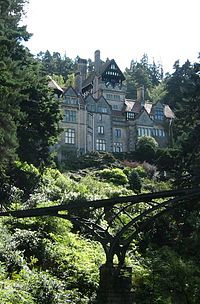- Cragside
-
Cragside
Cragside, NorthumberlandType Country House Proprietor National Trust Size 400 hectares (1.54 sq mi) Main feature Victorian country house Other features Gardens Public access Yes Museum Yes Exhibition Yes Country England Region North East UK Grid square NU0702 Address Rothbury, Morpeth, Northumberland Postcode NE65 7PX Refreshments Yes Parking Yes Shop Yes 55°18′49″N 1°53′08″W / 55.31361°N 1.88556°WCoordinates: 55°18′49″N 1°53′08″W / 55.31361°N 1.88556°W Cragside is a country house in the civil parish of Cartington in Northumberland, England. It was the first house in the world to be lit using hydroelectric power. Built into a rocky hillside above a 4 km² forest garden, it was the country home of Lord Armstrong and has been in the care of the National Trust since 1977.
Cragside, named after Cragend Hill above the house, was built in 1863 as a modest two-storey country lodge, but was subsequently extended to designs by Norman Shaw, transforming it into an elaborate mansion in the Free Tudor style. At one point, the building included an astronomical observatory and a scientific laboratory.
In 1868, a hydraulic engine was installed, with water being used to power labour-saving machines such as laundry equipment, a rotisserie and a hydraulic lift. In 1870, water from one of the estate's lakes was used to drive a Siemens dynamo in what was the world's first hydroelectric power station. The resultant electricity was used to power an arc lamp installed in the Gallery in 1878. The arc lamp was replaced in 1880 by Joseph Swan's incandescent lamps in what Swan considered 'the first proper installation' of electric lighting.
The generators, which also provided power for the farm buildings on the estate, were constantly extended and improved to match the increasing electrical demand in the house.
The Grade I listed[1] house is surrounded by one of Europe's largest rock gardens, a large number of rhododendrons and a large collection of mostly coniferous trees.
The documentary series Abroad Again in Britain by Jonathan Meades focused on Cragside in episode 2 (2005).
In 2007, Cragside reopened after undergoing "total refurbishment."[2]
Cragside was featured during the 21 August 2011 episode of BBC One's Britain's Hidden Heritage programme.
References
- ^ Details from listed building database (236348) - Grade I. Images of England. English Heritage.
- ^ Vanessa Thorpe (2007-03-31). "Restored: the world's first hydroelectric house". London: guardian.co.uk. http://www.guardian.co.uk/environment/2007/apr/01/energy.theobserversuknewspages. Retrieved 2010-07-17.
External links
River Coquet
SettlementsElectricity generation in North East England Generating
sitesActiveProposed/FutureActiveLynemouth · WiltonClosedBerwick upon Tweed · Blyth · Carville · Chopwell Colliery · Close · Consett · Darlington · Derwenthaugh Coke Works · Dunston · Forth Banks · Hebburn · Horden Colliery · Lemington · Mainsforth Colliery · Manors · Morrison Busty Colliery · Neptune Bank · Newburn Steelworks · North Tees · Ouston Colliery · Pandon Dene · Philadelphia · South Shore Road · South Shields · Stella · Sunderland · Vane Tempest Colliery · WhinfieldProposed/FutureEston Grange (Gasification)Refused/ShelvedBlyth Clean Coal · KepierActiveProposed/FutureConocoPhillips Teesside · Thor CogenerationRefusedNewburnActiveClosedCragsideActiveRefusedActiveWiltonActiveTeesside · Path Head landfillClosedFutureNorth Eastern Energy Recovery Centre · Wilton 11RefusedActiveBlyth Harbour · Blyth Offshore · Broom Hill · Great Eppleton · Hare Hill · High Sharpley · High Volts · Holmside Hall · Kirkheaton · Langley Park · Tow Law · Trimdon Grange · Walkway · West DurhamFutureBlyth Harbour (repowering) · Butterwick Moor · Great Eppleton (repowering) · Haswell Moor · Kiln Pit Hill · Lynemouth · Royal Oak · TeessideProposedBarmoor South · Green Rigg · Kielder · Moorsyde · Ray Hill · South Sharpley · Steadings · Teeswind North · The Isles · Todd Hill · West Ancroft · Wingates
Organisations
and personnelA. Reyrolle & Company · C. A. Parsons and Company · CE Electric UK · Charles Algernon Parsons · Charles Hesterman Merz · Clarke Chapman · John Theodore Merz · L J Couves & Partners · Merz & McLellan · NaREC · Newcastle and District Electric Lighting Company · North Eastern Electric Supply Company · Northern Electric · Northern Engineering Industries · Pre-nationalisation North East electric power companiesCategories:- Gardens in Northumberland
- Country houses in Northumberland
- National Trust properties in Northumberland
- Tudor Revival architecture
- Grade I listed houses
- Grade I listed buildings in Northumberland
- Historic house museums in Northumberland
- Hydroelectricity in the United Kingdom
- Science museums in the United Kingdom
- Technology museums in the United Kingdom
Wikimedia Foundation. 2010.


